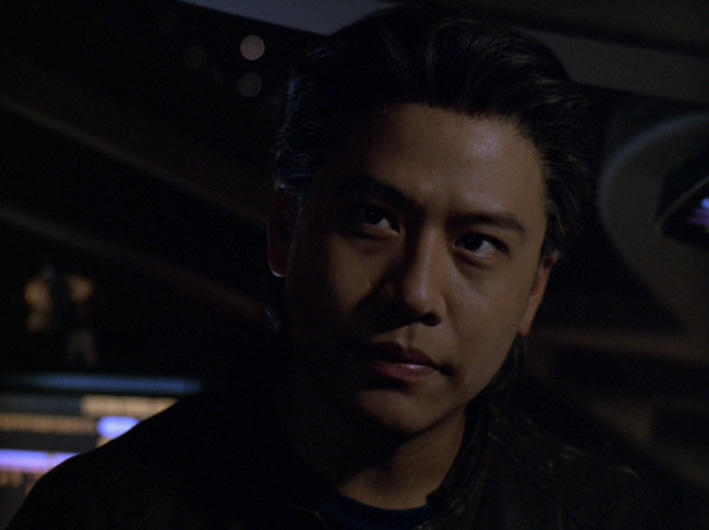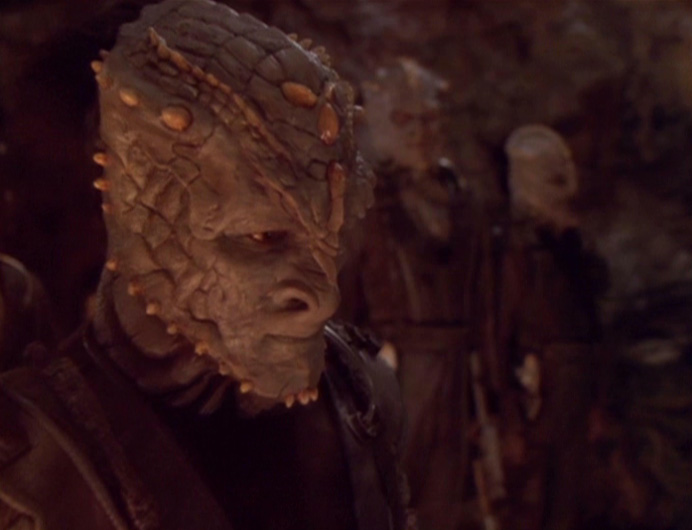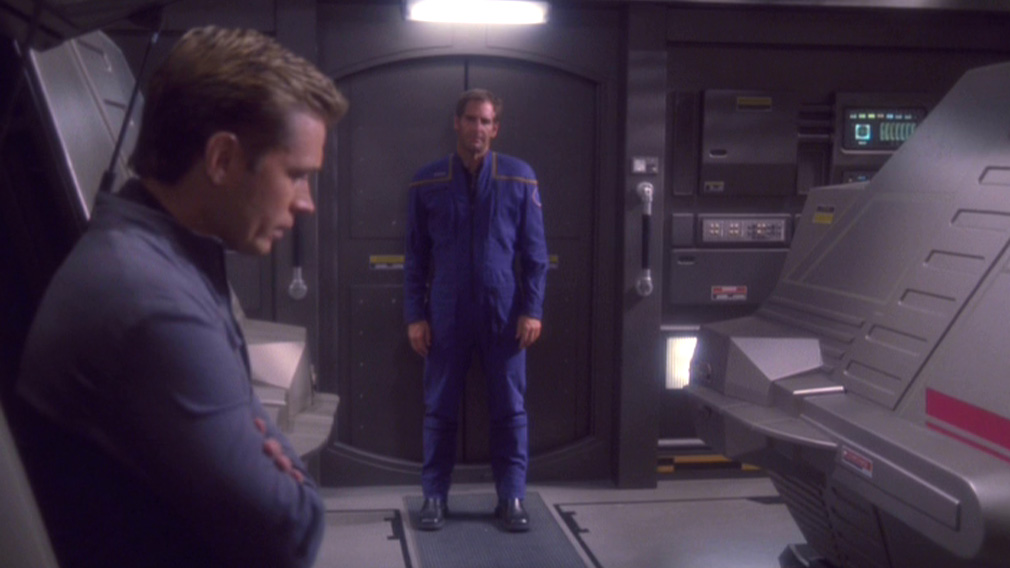On September 8th, 2016, the Star Trek franchise will officially turn 50, and what better way to celebrate than to count down the 50 greatest Star Trek stories in the canon? Deadshirt Founder and Editor Emeritus Dylan Roth pored through the 728 episodes and films to select the Top 50 Star Trek Voyages.
#30: “Timeless”
Star Trek: Voyager
Season Five, Episode Six
Originally aired November 18th, 1998
Story by Rick Berman, Brannon Braga, & Joe Menosky
Teleplay by Brannon Braga & Joe Menosky
Directed by LeVar Burton
If you’ve been reading this column from the beginning, then you’ve already gathered that I don’t think much of Star Trek: Voyager as a series. It’s not as bad a show as Enterprise is at its worst, but it also rarely approaches the quality of the Star Trek that came before, and a lot of that comes down to the characters. Most of the crew of Voyager is entirely forgettable or even unlikeable. (Enterprise suffers from the same problem, but that show grew and evolved more in its final two seasons than Voyager did in seven.) So, for a long time, I used to joke with my friends that my favorite Voyager episodes were the ones in which the crew suffered or died. Half of that was just being mean, but the other half came out of a desire to see the Voyager crew face some real adversity, even if most of the episode was erased from continuity by the end credits.
Voyager‘s best formal “reset button” episode is “Timeless.” “Timeless” is the 100th episode of Voyager, and the creative team chose to celebrate this achievement by crashing the ship to an icy death. The episode opens in the future, where an aging Harry Kim and Chakotay discover the wreck of Voyager under a sheet of ice on a faraway world, where it’s been for fifteen years. A flashback to the present day of the show reveals that Voyager has discovered a new kind of propulsion that could take them all the way back to the Alpha Quadrant in a matter of hours instead of decades, but that a miscalculation by Harry Kim led to the deaths of all but himself and Chakotay. Ever since, Harry has suffered from crippling survivor’s guilt, but now he’s found both the ship and a method to prevent its destruction using illegal time-bending tech. With the help of Chakotay and the reactivated Doctor, Harry’s going to correct his calculations and get Voyager home safely, saving the lives of the friends he failed all those years ago.
Of all of Voyager‘s regular cast, Garrett Wang is the most underused as put-upon Ensign Harry Kim. He’s a viewpoint character in the pilot episode, but beyond that gets very little development and comes across as the second-blandest crew member, after Chakotay. Chakotay is no more interesting in “Timeless” than he is in any other episode, but here, Wang gets to explore an entirely new version of his character. Kim’s defining characteristic in Voyager is his youth and relative inexperience, which leads to some insecurity. And as a young man, this version of Kim had those insecurities confirmed. He wasn’t good enough, and as a result, his entire crew died. He has spent fifteen years living with his failure, and now he has a chance to fix it, to finally feel worth a damn. Kim’s breakdown toward the end of the episode is stirring, an example of the kind of emotion that Voyager as a series could have used a lot more of.
Further Viewing: If you want to see an episode in which Voyager faces impossible odds and faces real consequences for two whole hours before the reset button gets hit, check out the two-parter “Year of Hell” from the fourth season, which very nearly made this countdown.
#29: “Rocks and Shoals”
Star Trek: Deep Space Nine
Season Six, Episode Two
Originally aired October 6th, 1997
Written by Ronald D. Moore
Directed by Michael Vejar
The sixth season of Deep Space Nine begins with an unprecedented six-part story (seven if you count the fifth season finale) informally known as the Dominion War arc. The Dominion War, in fact, continues until the end of the series, but this arc is when the Cold War between the benevolent Federation and the fascist Dominion rolls to a boil, with the Dominion launching a full-on invasion of the Alpha Quadrant. Deep Space 9 itself has been captured, occupied by Dominion and Cardassian troops led by Gul Dukat. While some of the non-Starfleet crew has elected to stay and mount an insurrection, the rest of the series leads have fled aboard the Defiant, which is now part of a fleet trying to push back the invasion at large.
The entire arc is excellent, but “Rocks and Shoals” is undoubtedly the strongest chapter. Here, Sisko and company crash land a captured Jem’Hadar ship on a deserted planet, only kilometers from where the ship that shot them down has also been beached. Each crew faces the grim reality of being stranded with limited resources. Sisko’s crew is in hostile territory with no way to call for help. The Dominion commander, a Vorta named Keevan (Christopher Shea), has a broken transmitter that he can’t fix, and not enough Ketracel-White—the drug that keeps his violent Jem’Hadar soldiers under control—to last the week. When it runs out, they’ll go mad and kill everyone, including their commander.
Keevan proposes a secret truce: he’ll lead his men into an ambush, giving Sisko’s crew a chance to wipe them out, then Chief O’Brien will fix the transmitter, call for Starfleet evac, and Keevan will rest comfortably as a Federation prisoner of war. Ordinarily, for a Starfleet Captain—an honorable future human who sees violence and deception as tools of the cowardly—this would be an unacceptable bargain. But this is war, and Sisko is a battlefield commander now. He’s going to have to do some dreadful things if he, his crew, and the Federation are going to survive.
While there are fine performances from regular and recurring cast members like Avery Brooks and Andrew J. Robinson on display, the MVP of “Rocks and Shoals” is Phil Morris as Remata’Klan, the ranking Jem’Hadar in Keevan’s regiment. Like all Jem’Hadar, Remata’Klan is genetically programmed to obey the Founders and the Vorta, but he’s not a machine. He’s a man, maybe even a good one. He knows he’s being used, but he also sees what’s happening around him and he knows he can’t stop it. So, throughout, he carries himself with dignity. He tends to his ailing troops. And, finally, he charges into the crossfire.
Like so many Deep Space Nine episodes, “Rocks and Shoals” isn’t a “message show” and it’s dark and violent, but it still embodies the values of Star Trek. It’s a story that seeks to show the humanity in everyone, even your mortal enemy.
#28: “Similitude”
Star Trek: Enterprise
Season Three, Episode Ten
Originally aired November 18th, 2003
Written by Manny Coto
Directed by LeVar Burton
“I have his memories. I have his feelings. I have his body. How am I not Trip?”
Rick Berman’s later Trek series developed a bad habit of recycling stories that weren’t even that old yet. Several episodes of Voyager are TNG stories with the serial numbers filed off, and Enterprise did the same thing with Voyager scripts. On paper, “Similitude” is a carbon copy of the early Voyager episode “Tuvix,” but the experience of watching them both reveals that, if anything, “Similitude” is a vastly superior remake. In “Tuvix,” two crew members are accidentally joined into one new person, and by the time a method is devised to split him back up, he doesn’t want to sacrifice himself to restore the status quo. In “Similitude,” a rapidly-aging clone is created as a brain tissue donor for a comatose Trip, but when it’s discovered that the procedure will be fatal, the clone refuses to participate, preferring to gamble on an experimental treatment that would let him live a full human lifespan.
On a story level, there are two main qualities that make “Similitude” more engaging: first, the stakes of Enterprise’s mission (this episode takes place during the season-long Xindi arc, where Enterprise is the only hope to save a doomed Earth) are much higher than Voyager’s. Second, where “Tuvix” is set into motion by accidentally creating a new life, “Similitude” is about creating a person purely as a means to an end, and then having to cope with the consequences of that dubious choice. Captain Archer and Dr. Phlox begin by willfully doing something wrong out of desperation, and they suffer for it. What’s more, the pain of this story doesn’t just disappear after the episode ends—that can’t be said for poor Tuvix, who is murdered (and he calls it that) in the final scene and is never spoken of again.
But what really makes this episode far and away better than its predecessor is Manny Coto’s script (his first for the show, and he’d be made showrunner the following season) and uncharacteristically strong performances from a usually weak cast. Connor Trinneer spends the back half of this episode playing the adult version of Trip’s clone Sim, who both is and isn’t the same person, and he does a wonderful job conveying that confusion. Jolene Blalock’s T’Pol struggles to keep her distance from this doomed man who resembles the one she secretly loves. And Scott Bakula gets to explore a side of Jonathan Archer that is downright menacing, giving the audience one of their first looks at just how much this mission is cutting away at his soul. Together, this all amounts to a gripping emotional story that pulls no punches.
Further Reading: Surprisingly few Star Trek episodes deal with cloning, but the polarizing tenth feature film Star Trek: Nemesis sees Picard squaring off against a young clone of himself (Tom Hardy), and the dynamic between them is the only part of the film that works.
#27: “Duet”
Star Trek: Deep Space Nine
Season One, Episode Nineteen
Originally aired June 13th, 1993
Story by Lisa Rich & Jeanne Carrigan-Fauci
Teleplay by Peter Allan Fields
Directed by James L. Conway
The Bottle Episode: it’s one of the great trials most “genre” series must confront at one time or another, a story that is told with as few new sets, effects, and guest stars as possible in order to free up the budget needed for another, flashier episode. It’s a test that can determine the strength of your show, and whether or not your series relies too heavily on action or effects—without complex characters, without a solid core concept, any bottle show is going to end up intolerably boring. But at the end of a disappointing freshman year, Deep Space Nine managed to pull off one of the best bottle episodes ever, and reveal the true strengths of what would become the best Star Trek series.
In “Duet,” a passenger, Amin Maritza (Harris Yulin), arrives at the station, and Major Kira accuses him of being a Cardassian war criminal. In her attempts to prove it, Kira and Maritza square off in a series of interrogations that, to the delight of the audience, end up revealing much more about her than about him. A former “terrorist” who took part in the resistance against the Cardassian occupation of her world, Kira’s got a lot of blood on her hands, and she’s never really confronted her feelings or her actions. Now she finds herself on a quest for vengeance, but can anything actually give her or her people any peace?
“Duet” forecasts all of the traits that will go on to separate DS9 from its predecessors: character growth, moral ambiguity, and a dark twist. It’s appropriate that Kira should be the center of the first great DS9 story; Sisko may be top billed, but it’s Kira who goes through the most dramatic transformation throughout the series, from an angry, hateful warrior saddled with an assignment she doesn’t want into a true leader tempered by compassion and friendship. This is the beginning of Kira putting the Resistance behind her, and while it never really goes away (no cultural trauma ever does), it does begin to feel like the past, rather than a waking nightmare without an end.
#26: “Where No Man Has Gone Before”
Star Trek
Season One, Episode One
Originally aired September 22nd, 1966
Written by Samuel A. Peebles
Directed by James Goldstone
Star Trek’s second pilot is notable enough just for its historical significance, being the first Kirk story, and the episode on which the series was finally sold. But it’s not only an important episode, it’s also a very good one, a tragedy about friendship and sacrifice. In “Where No Man Has Gone Before,” the (slightly different) Enterprise crew attempts to breach the edge of galaxy, and encounter a phenomenon that instantly kills several officers and fundamentally alters another—Kirk’s former student and close friend, Lt. Gary Mitchell (Gary Lockhart). Gary begins to develop godlike powers, but as his power grows, so does his madness. Kirk is left with no choice but to kill Gary, if he still can.
Despite being the first produced episode of Star Trek proper (“The Cage” being an orphan of sorts from a series that never was), “Where No Man Has Gone Before” has a sense of history behind it. This is Gary Mitchell’s only appearance, but his interactions with Kirk and Spock imply a relationship not unlike the one they would later share with Dr. McCoy. But he’s also a reflection of Kirk, younger and more cocky, not a far climb from Chris Pine’s Kirk in the relaunched film series. The kinship between these men is sold perfectly, and it’s the fuel that makes the episode work.
There’s also one-shot guest star Sally Kellerman as Dr. Elizabeth Dehner, ship’s psychiatrist, who is fascinated by Gary’s transformation and speaks as his advocate to the rest of the crew. She’s McCoy’s real emotional predecessor, which leads her finally to become the true hero of the episode. As always, sixties gender politics muddy things up a bit for the modern viewer, but for the time, the script allows Dr. Dehner a lot of agency and nuance. Despite the strange course the show took just to get this second pilot (or perhaps because of it), it turned out to be a marvelous start to the series. 50 years later, here we are.
#25-21 This Thursday: Spies, children, time and anti-time.






